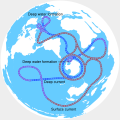Drake Passage
The Drake passage is a body of water. It lies between the Atlantic and Pacific oceans. To the north is Cape Horn and the South American continent, to the south are the South Shetland Islands, now part of the British Antarctic Territory. It is part of the Southern Ocean. It is named after the English privateer Sir Francis Drake, who accidentally discovered it. He never sailed the passage, because sailing the Strait of Magellan was less dangerous.
The Drake passage is also the shortest route from Antarctica to the rest of the world. The only islands in the passage are the Diego Ramirez Islands, about 60 km south of Cape Horn.
The passage is also known for very rough seas. Waves of 10 m are not uncommon here.
The passage is also good for seeing Whales, Dolphins, seabirds, and penguins.
In old books, the passage is called Drake Strait. In Spanish it is called "Pasaje de Drake" or "Mar de Moces".
Drake Passage Media
Drake Passage showing the boundary points A, B, C, D, E and F accorded by the Treaty of Peace and Friendship of 1984 between Chile and Argentina
Depth profile with salinity and temperature for surface
The Drake Passage (middle of image) in relation to the global thermohaline circulation (animation)
The Drake Passage influences the global surface temperature and Atlantic circulation.
A light-mantled sooty albatross flying over the Drake Passage
Other websites
- National Oceanography Centre, Southampton page of the important and complex bathymetry of the Passage Archived 2010-07-02 at the Wayback Machine
- A personal story describing crossing the Passage Archived 2013-10-07 at the Wayback Machine
- A NASA image of an eddy in the Passage Archived 2004-12-04 at the Wayback Machine
- Larger-scale images of the passage from the US Navy (Rain, ice edge and wind images) Archived 2004-10-23 at the Wayback Machine
- BBC News story on a scientific study dating the age of the Drake Passage










